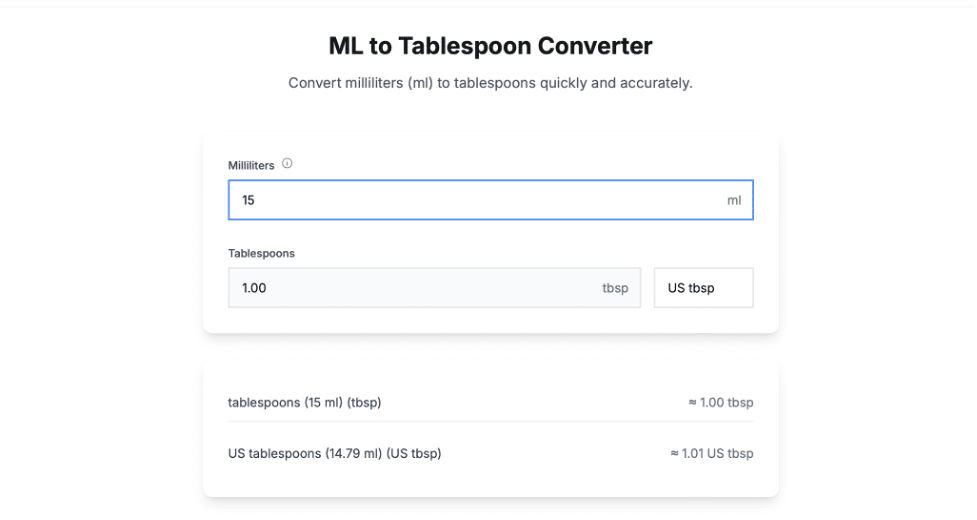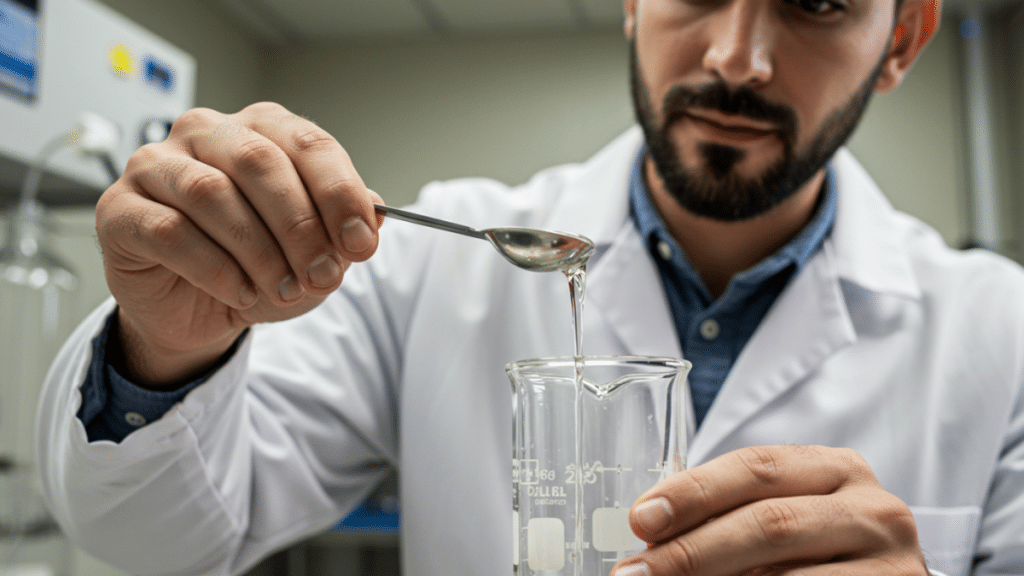Whether you’re cooking, baking, or measuring ingredients for a DIY project, understanding measurements is crucial for precision. One of the most common questions when dealing with recipes or instructions is: “How many milliliters (ml) are in a tablespoon?” This simple yet essential conversion can make all the difference in achieving the desired results. In this article, we’ll explore the answer and provide helpful tips for measurements.
Ml to Tablespoon Converter
You can just avoid the details and use our ml to tablespoon converter or tablespoon to ml converter.

The Answer: How Many ml in a Tablespoon?
The exact number of milliliters in a tablespoon depends on the measurement system used, as it can vary slightly between countries. Here’s a breakdown:
In the United States:
1 tablespoon (tbsp) = 14.79 ml
While 14.79 ml is the precise conversion, it is often rounded to 15 ml for simplicity.
In the United Kingdom and Canada:
1 tablespoon (tbsp) = 15 ml
These countries follow the metric system, which aligns closely with the rounded US measurement.
In Australia:
1 tablespoon (tbsp) = 20 ml
Australians use a larger tablespoon measurement than most other countries, which is important to note when following recipes from Australia.
How to Convert Tablespoons to Milliliters
If your recipe requires measurements in tablespoons and you only have a milliliter measuring tool (or vice versa), you can easily convert between the two:
From tablespoons to milliliters:
Multiply the number of tablespoons by the ml equivalent for your region.
Example: 3 tablespoons (US) × 14.79 = 44.37 ml
From milliliters to tablespoons:
Divide the number of milliliters by the ml equivalent for your region.
Example: 45 ml ÷ 15 (UK) = 3 tablespoons

Who Invented this Metric
The metric system was officially introduced in 1795 during the French Revolution. Before this, there was a confusing mix of local and regional measurement systems in France, making trade, science, and everyday life cumbersome. To address this, the French government sought to create a system that was uniform, logical, and based on natural constants.
Key Figures Behind the Metric System
Gabriel Mouton (1670):
Often called the “father of the metric system,” Gabriel Mouton, a French priest and mathematician, first proposed a decimal-based system of measurement in the 17th century. He suggested using the Earth’s circumference as a basis for defining units of length.
Jean-Baptiste Delambre and Pierre Méchain (1792-1799):
These French astronomers were tasked with measuring the meridian arc from Dunkirk to Barcelona to define the meter. Their work helped establish the meter as one ten-millionth of the distance from the equator to the North Pole.
The French Academy of Sciences:
This institution played a major role in refining and implementing the metric system. They established base units like the meter for length, the liter for volume, and the gram for weight, all based on natural measurements.
When Was the Milliliter Defined?
The liter was defined in 1795 as the volume of a cube with sides measuring 0.1 meters (10 cm). From this, the milliliter was derived as one-thousandth of a liter (hence the prefix “milli-,” meaning one-thousandth). The milliliter became widely used for measuring small quantities of liquids.
Why Was the Metric System Invented?
The primary goals were:
Simplicity and Standardization: A unified system that everyone could use without confusion.
Decimal-Based System: Easier calculations using powers of ten.
Scientific Accuracy: Units based on natural phenomena rather than arbitrary references.
Global Adoption
Over time, the metric system became the international standard for measurements. Today, almost every country in the world uses the metric system, with a few exceptions like the United States, which still relies on the customary system for everyday measurements.
So, while no single person “invented” the milliliter, it was a product of the metric system’s development—an achievement of French scientists, mathematicians, and policymakers striving for precision and global unity in measurements.
Pro Tips for Accurate Measuring
Use the Right Measuring Tools:
To ensure precision, use measuring spoons or cups designed for the system your recipe follows.
Check the Source of Your Recipe:
Recipes from the US, UK, or Australia may use different tablespoon measurements. Adjust accordingly if you’re using a recipe from another country.
Invest in a Kitchen Scale:
For highly accurate measurements, consider using a digital kitchen scale that can measure ingredients in grams and milliliters.
Common Questions
Can I use a regular spoon instead of a measuring tablespoon?
It’s not recommended. Regular spoons vary in size and won’t provide accurate measurements.
Is there a difference between liquid and dry tablespoon measurements?
The volume remains the same (e.g., 15 ml for the US), but it’s important to level off dry ingredients for accuracy.
Why Does It Vary by Country?
The variation in tablespoon sizes comes from differences in measurement systems. The US uses its own customary system, while most other countries follow the metric system. Australia, however, decided to adopt a larger tablespoon measurement for standardization.
This difference is important when following recipes. If you’re using a recipe from a different country, double-check the measurements to ensure accuracy.
Why Knowing This Is Important
Accurate measurements can make or break your recipe, especially in baking or when working with strong ingredients like spices, vinegar, or oils. Using too much or too little can affect the flavor, texture, or even the safety of the dish.
For example, if a recipe calls for 1 tablespoon of vanilla extract (15 ml) and you mistakenly use 20 ml, the flavor could become overpowering. On the other hand, using less than required could make your dish taste bland.
Tips for Measuring Accurately
Use Measuring Spoons:
Avoid using regular spoons, as they vary in size and won’t give you accurate results.
Level Off Dry Ingredients:
When measuring dry ingredients like flour or sugar, use a knife to level off the top of the spoon for accuracy.
Check Your Recipe’s Origin:
Recipes from the US, UK, or Australia may use different tablespoon sizes, so adjust your measurements accordingly.
Invest in a Kitchen Scale:
For ultimate precision, use a digital kitchen scale that can measure both weight (grams) and volume (milliliters).
When Milliliters Matter Beyond Cooking
Measuring in milliliters isn’t just for cooking. It’s also helpful in:
Mixing cleaning products.
Measuring liquid fertilizers for gardening.
Creating DIY beauty products like lotions or hair masks.
